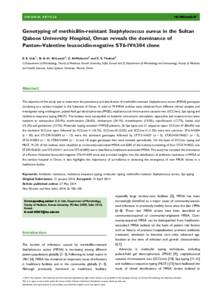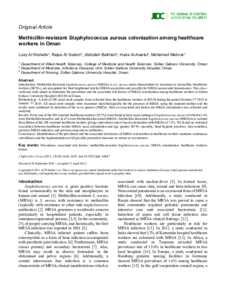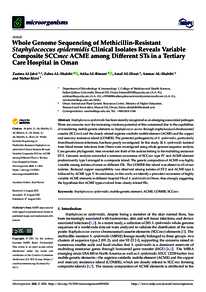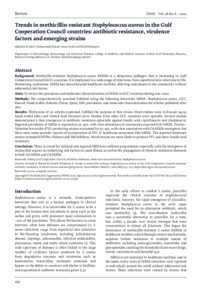Document
Genotyping of methicillin-resistant staphylococcus aureus in the Sultan Qaboos University Hospital, Oman reveals the dominance of panton-valentine leucocidin-negative ST6-IV/t304 clone.
Identifier
DOI: 10.1002/nmi2.47
Contributors
Publisher
Elsevier Ltd.
Gregorian
2014-05
Language
English
Subject
English abstract
The objective of this study was to determine the prevalence and distribution of methicillin-resistant Staphylococcus aureus (MRSA) genotypes circulating at a tertiary hospital in the Sultanate of Oman. A total of 79 MRSA isolates were obtained from different clinical samples and investigated using antibiogram, pulsed-field gel electrophoresis (PFGE), staphylococcal chromosome cassette mec (SCCmec), Spa typing and multilocus sequence typing (MLST). The isolates were susceptible to linezolid, vancomycin, teicoplanin, tigecycline and mupirocin but were resistant to tetracycline (30.4%), erythromycin (26.6%), clindamycin (24.1%), trimethoprim (19.0%), ciprofloxacin (17.7%), fusidic acid (15.2%) and gentamicin (12.7%). Molecular typing revealed 19 PFGE patterns, 26 Spa types and 21 sequence types. SCCmec-IV (86.0%) was the dominant SCCmec type, followed by SCCmec-V (10.1%). SCCmec-III (2.5%) and SCCmec-II (1.3%) were less common. ST6-IV/t304 (n = 30) and ST1295-IV/t690 (n = 12) were the dominant genotypes followed by ST772-V/t657 (n = 5), ST30-IV/t019/t021 (n = 5), ST22-IV/t852 (n = 4), ST80-IV/t044 (n = 3) and 18 single genotypes that were isolated sporadically. On the basis of SCCmec typing and MLST, 91.2% of the isolates were classified as community-associated MRSA and 8.8% of the isolates (consisting of four ST22-IV/t852, one ST239-III/t632, one ST5-III/t311 and one ST5-II/t003) were classified as healthcare-associated MRSA. The study has revealed the dominance of a Panton-Valentine leucocidin-negative ST6-IV/t304 clone and provided insights into the distribution of antibiotic resistance in MRSA at the tertiary hospital in Oman. It also highlights the importance of surveillance in detecting the emergence of new MRSA clones in a healthcare facility.
Member of
ISSN
2052-2975
Resource URL
Category
Journal articles





